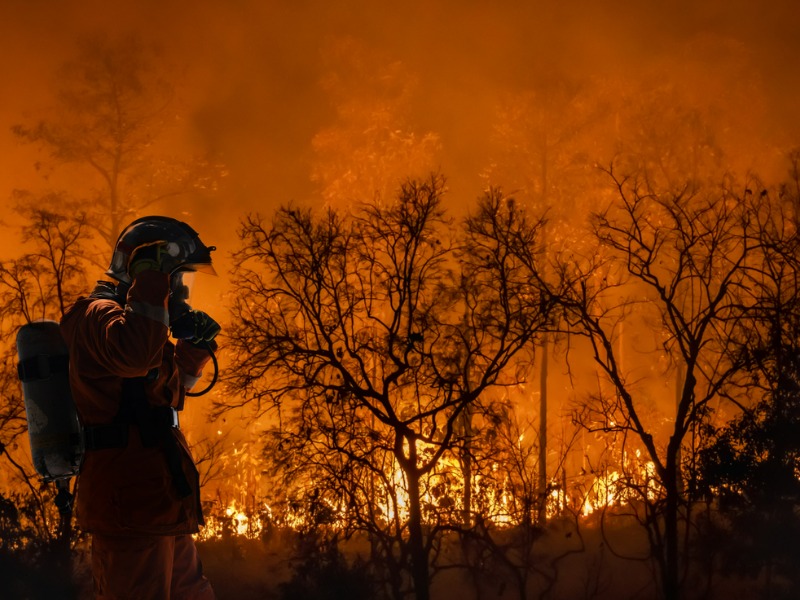What the industry learned from a 20-year-old wildfire

The devastation of British Columbia’s Okanagan Mountain Park wildfire in 2003 was unlike anything Janna Smart had adjusted before.
“It was full of raw emotion, chaos, destruction, and limited experience in handling a wildfire in a densely populated area. It was all too surreal,” said the branch manager and senior adjuster for ClaimsPro in Penticton, B.C. More than 27,000 people were evacuated and 239 Kelowna-area homes destroyed.
That wildfire alone cost the Canadian P&C industry more than $200 million in insured losses – and represented a turning point in the way future fires were addressed by governments, firefighting agencies and the insurance industry.
“We learned that many of the homes were underinsured, and so began our journey into wildfire management,” Smart said. New FireSmart programs in the province encouraged property owners to clear ignitable sources from their yards, teaching them how a small grass fire can grow. B.C.’s Okanagan region deemed cedar shake panel roofs unsafe and banned them as a building material. Government bodies began to establish plans for evacuation routes and emergency centres, complete with the needed funding.
Communication plans regarding fire suppression efforts were altered as well. “Reporting styles have changed,” Smart said. “A more sensitive approach has been taken to protect the general public from learning [from a news report] all that they’d loved and known as a home was reduced to rubble.”
But it appears many recommendations were not carried out or even implemented in a final report following the 2003 fire. “We have a history of doing a good job at dissecting events after they happen, putting together glossy reports with lots of recommendations, then putting them on a shelf and not doing anything about the recommendations,” said Glenn McGillivray, managing director of the Institute for Catastrophic Loss Reduction (ICLR).
Setting guidelines
ICLR is pushing to make the National Research Council of Canada (NRC)’s National Guide for Wildland-Urban Interface Fires into a wildfire building code, McGillivray notes.
There is no broad-based discussion for a national rule, he says, but Lytton, B.C., has already incorporated NRC guide requirements into a building bylaw written by ICLR. It addresses Class A fire-rated roof covers; non-combustible siding such as cement fibre board; non-combustible decking material like stone or cement; restrictions against planting vegetation against houses; and space between propane tanks and homes.
Lytton, which holds the dubious distinction as the hottest place in Canada, recorded three consecutive days of record heat culminating in a high of 49.6°C before its June 30, 2021 wildfire. Insured losses from that event, which destroyed 90% of the village, totalled more than $102 million.
Ryan Dobson, a fire and explosion investigator with forensic engineering firm Origin and Cause, thought of his time at Calgary Police’s homicide unit when he first arrived in the village. “I recall how oddly serene even the worst homicide scenes were, where you stood alone in a room that appeared frozen in time,” he says. “Lytton looked and felt just like that to me.”
Setting records
Last year, Canada’s wildfire season smashed the previous record of 7.3-million burned hectares set in 1989. By Oct. 10, more than 6,500 fires had burned across 18.5 million hectares, according to the Canadian Interagency Forest Fire Centre.
Like 20 years prior, B.C.’s Okanagan region took centre stage. The McDougall Creek wildfire in August, 2023 cost more than $480 million in insured damage, Catastrophe Indices and Quantification (CatIQ) says. The Bush Creek East fire in B.C.’s Shuswap region also around that time cost $240 million in insured damage. In Nova Scotia, losses from the Tantallon wildfire last May and June have already been calculated at $165 million in insured damage.
It’s often difficult to determine the full catastrophic costs of individual fires, as each could be considered a separate event, said Rob de Pruis, national director of consumer and industry relations with Insurance Bureau of Canada (IBC). As well, CatIQ only begins tracking data when insured damage is above $30 million.
To date, the country’s costliest natural disaster remains the May 2016 wildfire in Fort McMurray, Alta. “That was a [more than] $4-billion wildfire event in one area,” de Pruis said. “Many of the fires we’re experiencing now across the country are in less populated, more rural areas, so there’s not as much insured damage.”
With record-breaking hectares burned last year, that wildfire season looks much worse than previous years. And McGillivray sees it as part of a long-term pattern rather than a blip.
“We have seen a doubling in area burned in Canada since the 1970s despite new technologies to locate and fight fires,” he said. “And we are projected to see yet another doubling — possibly a trebling — by 2100.”
This story is excerpted from one that appeared in the November print edition of Canadian Underwriter. Feature image by iStock.com/Toa55







